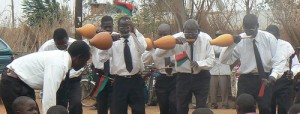
Each of the tribes performs their traditional dances for particular function or ceremony, and these traditional dances help to spice up the daily lives of African people. As villagers live in small communities, their daily activities are linked and do most of activities together. They eat together. Families bring food and eat together. They farm together, from one family’s farm they rotate to others.
The Mganda
Like other dances, Mganda is common among the Chewa tribe of central Malawi. This is probably the second most popular dance after Gule wa Mkulu (Big dance) among the Chewa. It is practiced mostly in such districts as Dowa, Lilongwe, Ntchisi, Dedza and Kasungu, and is primarily an entertainment dance performed during wedding ceremonies. The dancers are usually in a group of 6 to 10, sometimes more with a drummer in front of the dancers.
Men who form two or three lines facing the same direction perform it but, as they dance, they systematically face all directions. The dancers hold small flags and a ‘badza’ (made from a gourd). During wedding ceremony performance, entertained viewers throw money to the most entertaining dancer. After a performance, the group is awarded/paid for the performance. Apart from entertainment alone, the dance is a source of income for the members.
Mganda is also performed merely for entertainment on functions such as political party rallies. Like sister dance, Chimtali (which is performed by women), Mganda is also performed during the night in the moon light in villages for entertainment. People come from all corners of the village and surrounding villages to watch men dancing. This group of Mganda dancers is based in Mponela area in Dowa district.
Another popular form of dance practiced in the villages is Chitelera. Chitelera is mostly performed for entertainment on full-moon nights by young girls, but also is used as a form of inter-village competition. Teams of girls travel to neighboring villages to see which village has more talented dancers. Girls form cycles as they dance.
This Mganda group was captured as it entertained people when a hospital was receiving a donation of medical supplies from the Malawi Project.
Wilson Tembo
